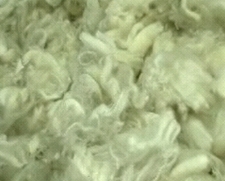
Australian Wool Industries Secretariat Inc (AWIS) releases wool sales report for week ending November 2. The Australian Wool Exchange (AWEX) Regional Indicators finished 0.3% lower, on average, at sales in Sydney, Melbourne and Fremantle this week. The US exchange rate rose by 0.1%. It was another very solid market, but without the large price rises of recent weeks. It was also the largest sale of the season, due to the release of previously unsold wool onto the market in response to the recent rises in wool prices. Wednesday's sale finished with good gains at the fine end in the South, but lesser gains in the North.
Medium Merino wools were down slightly. Thursday's movements in the average AWEX Micron Price Guide (MPGs) were in similar direction to those on Wednesday. Trade reports indicate that the market finished on strong note on Thursday.
The 8¢ fall in the WMI compared with a 2¢ in the Eastern Market Indicator (EMI) looks to be associated with the absence of fine wools in the WMI. The further gains at the fine end have resulted in the average Micron Price Guide (MPGs) for 17.0 to 18.5 microns now being above their values at the start of the season. The 16.5 and 19.0 average Micron Price Guide (MPGs) are still slightly below their values at the start of the season.
The Eastern Market Indicator (EMI) finished the week 178¢ (-14.5%) less than in the same week last year and 24¢ (-2.2%) less than at the start of the season. The WMI is 178¢ (-14.4%) less than in the same week last year and is 15¢ (-1.4%) less than at the start of the season.
In South African sales, the Cape Wools Indicator was up by 4.0% in Rand and by 5.1% in US currency since last week. This rise may have nclude a catch-up component as the rise in last week's South African market was less than the rise in Australia.
Wool Services International in New Zealand quoted fine cross fleece wools as 3 to 4% cheaper and coarse crossbred wools as in sellers' favour. In other fibres, cotton Futures eased again during the week. December Futures closed at 70.35 US¢ on Friday, down by 2.9% since the previous week.
51,336 bales were on offer, compared with 40,634 bales last week. 6.7% were passed in, comprised of 5.2% in Sydney, 4.9% in Melbourne and 12.0% in Fremantle. Pass-in rates for Merino fleece and skirtings were 6.4% and 5.6%, respectively. All pass-in rates were up on last week, as usually occurs when a rising market steadies or eases. 47,906 bales were cleared to the trade.
The New Zealand Merino Company also offered 1,728 bales in Melbourne on Tuesday of which 11.1% were passed in. The year-to-date offering is 47,054 bales less (-7.1%) than at the end of the same week last year. The year-on-year difference is expected to move to less than 5% over the next three weeks as more wool is being released onto the market in response to the recent price rises.
The US exchange rate was relatively stable for the second week in a row. There was a shortage of economic data during the week to spark movements in either direction. Financial analysts appeared to spend a large part of their time this week speculating on whether or not the Reserve Bank will lower the cash rate when it meets on Tuesday. The expectation of a 25 points fall on Tuesday lessened during the week.
Skirtings continued to be in generally good demand, although an easing in prices was reported in Fremantle. Crossbreds were relatively unchanged during the week. Oddments were also relatively unchanged apart from washing locks which were reported as easing during the week.
Buyers for China were dominant this week, followed by strong support from buyers for Europe and India. The buying for Europe was again strong.
Sales will be held in Sydney, Melbourne and Fremantle next week, when 48,280 bales are currently rostered for sale. Present estimates for the following two sales (Weeks 20 and 21) are 48,120 and 47,450 bales, respectively; an increase of 10.3% over the three sale period when compared with last year.





